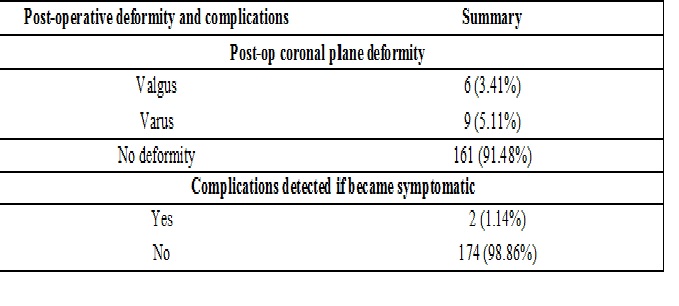Evaluation of tibial tray coronal plane alignment in total knee replacement using intramedullary JIG-a prospective study
Abstract
Introduction: Long term survivorship in total knee replacement [TKR] is significantly dependant on prosthesis alignment. In a standard total knee replacement, tibial component alignment is a key factor for the long-term success of the surgery.
Materials and Methods: A prospective observational study on 176 subjects who underwent TKR with intramedullary jig for tibial alignment with a minimum follow up period of 6 months was conducted in the Department of orthopaedics, KIMS Al Shifasuper-specialty hospital, Kerala. The Tibial component alignmentwas measured by the Tibial Component Angle [TCA] and Error in Tibial trayalignment. The other outcome variables were knee score, functional score, and Tourniquet time.
Results: The mean TCA in the study population was 90.56º±1.194º ranging from 86.45º to 94.05º. The mean error observed in tibial tray alignment was -0.56±1.199 degrees, ranging from -0.45 to + 3.55 degrees. Accuracy of TCA within 90 ± 2 degrees was achieved in 91.48% of subjects. The mean knee score at 6months was 89.45 ± 3.83. The mean functional score at 6months was 87.55 ± 4.93. The mean tourniquet time was 59.08 ± 5.88 minutes.
Conclusions: Intramedullary tibial referencing guide can be used in TKR with great accuracy (91.48%) to achieve desired coronal plane tibial component alignment (90o ±2o). When TCA was accurate, knee score and functional score were better than non-accurate TCA cases
Downloads
References
2. Ethgen O, Bruyère O, Richy F, et al. Health-related quality of life in total hip and total knee arthroplasty. A qualitative and systematic review of the literature. J Bone Joint Surg Am. 2004 May;86-A(5):963-74.[pubmed]
3. Maestro A, Harwin SF, Sandoval MG, Vaquero DH, Murcia A. Influence of intramedullary versus extramedullary alignment guides on final total knee arthroplasty component position: a radiographic analysis. J Arthroplasty. 1998;13(5):552-8. doi: 10.1016/s0883-5403(98)90055-9
4. Reed MR, Bliss W, Sher JL, et al. Extramedullary or intramedullary tibial alignment guides: a randomised, prospective trial of radiological alignment. J Bone Joint Surg Br. 2002 Aug;84(6):858-60.[pubmed]
5. Abdel MP, Oussedik S, Parratte S, et al. Coronal alignment in total knee replacement: historical review, contemporary analysis, and future direction. Bone Joint J. 2014 Jul;96-B(7):857-62. doi: 10.1302/0301-620X.96B7.33946.[pubmed]
6. Windsor RE, Scuderi GR, Moran MC, et al. Mechanisms of failure of the femoral and tibial components in total knee arthroplasty. Clin OrthopRelat Res. 1989 Nov;(248):15-9; discussion 19-20.[pubmed]
7. Fehring TK, Odum S, Griffin WL, et al. Early failures in total knee arthroplasty. Clin OrthopRelat Res. 2001 Nov;(392):315-8.[pubmed]
8. Berend ME, Ritter MA, Meding JB, et al. Tibial component failure mechanisms in total knee arthroplasty. Clin OrthopRelat Res. 2004 Nov;(428):26-34.[pubmed]
9. Zeng HB, Ying XZ, Chen GJ, Yang XQ, Lin DD, Li ZJ, et al. Extramedullary versus intramedullary tibial alignment technique in total knee arthroplasty: A meta-analysis of randomized controlled trials. Clinics (Sao Paulo). 2015;70(10):714-9. doi: 10.6061/clinics/2015(10)10
10. Ritter MA, Faris PM, Keating EM, et al. Postoperative alignment of total knee replacement. Its effect on survival. Clin OrthopRelat Res. 1994 Feb;(299):153-6.[pubmed]
11. Lozano LM, Segur JM, Maculé F, et al. Intramedullary versus extramedullary tibial cutting guide in severely obese patients undergoing total knee replacement: a randomized study of 70 patients with body mass index >35 kg/m2. Obes Surg. 2008 Dec;18(12):1599-604. doi: 10.1007/s11695-008-9564-1. Epub 2008 May 31.[pubmed]
12. Patil S, D'Lima DD, Fait JM, et al. Improving tibial component coronal alignment during total knee arthroplasty with use of a tibial planing device. J Bone Joint Surg Am. 2007 Feb;89(2):381-7. DOI:10.2106/JBJS.F.00204.[pubmed]
13. Karade V, Ravi B, Agarwal M. Extramedullary versus intramedullary tibial cutting guides in megaprosthetic total knee replacement. J OrthopSurg Res. 2012 Oct 2;7:33. doi: 10.1186/1749-799X-7-33.[pubmed]
14. Nam D, Jerabek SA, Haughom B, et al. Radiographic analysis of a hand-held surgical navigation system for tibial resection in total knee arthroplasty. J Arthroplasty. 2011 Dec;26(8):1527-33. doi: 10.1016/j.arth.2011.01.012. Epub 2011 Mar 11.[pubmed]
15. Cashman JP, Carty FL, Synnott K, et al. Intramedullary versus extramedullary alignment of the tibial component in the Triathlon knee. J OrthopSurg Res. 2011 Aug 20;6:44. doi: 10.1186/1749-799X-6-44.
16. da Rocha Moreira Rezende B, Fuchs T1, Nishi RN1, et al. Alignment of the tibial component in total knee arthroplasty procedures using an intramedullary or extramedullary guide: double-blind randomized prospective study. Rev Bras Ortop. 2015 Mar 12;50(2):168-73. doi: 10.1016/j.rboe.2015.02.013. eCollection 2015 Mar-Apr.[pubmed]
17. Blakeney WG, Khan RJ, Palmer JL. Functional outcomes following total knee arthroplasty: a randomised trial comparing computer-assisted surgery with conventional techniques. Knee. 2014 Mar;21(2):364-8. doi: 10.1016/j.knee.2013.04.001.[pubmed]
18. Chin PL, Yang KY, Yeo SJ, et al. Randomized control trial comparing radiographic total knee arthroplasty implant placement using computer navigation versus conventional technique. J Arthroplasty. 2005 Aug;20(5):618-26. DOI:10.1016/j.arth.2005.04.004.[pubmed]
19. Harikrishnan B, Prabhakara A, Joshi GR. Radiographic evaluation of tibial component alignment in total knee arthroplasty following extramedullary and intramedullary tibial referencing. Int J Res Orthop. 2017;3(6):1199-204. doi: 10.18203/issn.2455-4510.intjresorthop20174714



 OAI - Open Archives Initiative
OAI - Open Archives Initiative


















 Therapoid
Therapoid

